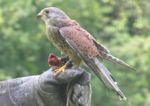Difference between revisions of "Avian Oral Cavity - Anatomy & Physiology"
Jump to navigation
Jump to search
m |
|||
| Line 1: | Line 1: | ||
| − | + | {{toplink | |
| − | + | |backcolour =BCED91 | |
| + | |linkpage =Alimentary - Anatomy & Physiology | ||
| + | |linktext =Alimentary System | ||
| + | |maplink = Alimentary (Concept Map)- Anatomy & Physiology | ||
| + | |pagetype =Anatomy | ||
| + | |sublink1=Avian Digestive Tract - Anatomy & Physiology | ||
| + | |subtext1=AVIAN DIGESTIVE TRACT | ||
| + | }} | ||
[[Image:Kestrel beak.jpg|thumb|right|150px|Beak of a kestrel - Copyright nabrown RVC]] | [[Image:Kestrel beak.jpg|thumb|right|150px|Beak of a kestrel - Copyright nabrown RVC]] | ||
==Introduction== | ==Introduction== | ||
Revision as of 22:04, 2 September 2008
|
|
Introduction
In avian species, the lips and cheeks are replaced by the beak.
The beak is an area of dense, horny skin overlying the incisive bones of the mandible.
No modern birds possess teeth, however rudimentary enamel organs have been discovered in the embryos of some birds.

